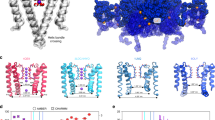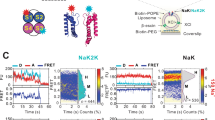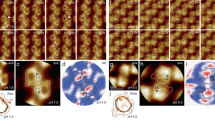Abstract
Potassium channels allow the selective flow of K+ ions across otherwise impermeable membranes. During a process called gating, these channels undergo a conformational change that proceeds from a closed to an open state. The closed state of KcsA, a prokaryotic potassium channel, has been structurally well characterized with equilibrium structural techniques. However, attempts to obtain a structural description of the gating transition of the channel have been hampered because the open state is only transiently occupied and, therefore, not readily accessible to such techniques. Here we describe a non-equilibrium technique that we call site-directed mass tagging and use this technique to probe the conformational change that KcsA undergoes during gating. The results indicate that KcsA is a dynamically modular molecule; the extracellular half of the membrane-spanning region is held rigid during gating, while the intracellular half undergoes a significant conformational change.
This is a preview of subscription content, access via your institution
Access options
Subscribe to this journal
Receive 12 print issues and online access
$189.00 per year
only $15.75 per issue
Buy this article
- Purchase on Springer Link
- Instant access to full article PDF
Prices may be subject to local taxes which are calculated during checkout




Similar content being viewed by others
References
Zhou, Y., Morais-Cabral, J.H., Kaufman, A. & MacKinnon, R. Chemistry of ion coordination and hydration revealed by a K+ channel–Fab complex at 2.0 Å resolution. Nature 414, 43–48 (2001).
Perozo, E., Cortes, D.M. & Cuello, L.G. Three-dimensional architecture and gating mechanism of a K+ channel studied by EPR spectroscopy. Nat. Struct. Biol. 5, 459–469 (1998).
Tatulian, S.A., Cortes, D.M. & Perozo, E. Structural dynamics of the Streptomyces lividans K+ channel (SKC1): secondary structure characterization from FTIR spectroscopy. FEBS Lett. 423, 205–212 (1998).
le Coutre, J., Kaback, H.R., Patel, C.K., Heginbotham, L. & Miller, C. Fourier transform infrared spectroscopy reveals a rigid α-helical assembly for the tetrameric Streptomyces lividans K+ channel. Proc. Natl. Acad. Sci. USA 95, 6114–6117 (1998).
Li, H.L. et al. Two-dimensional crystallization and projection structure of KcsA potassium channel. J. Mol. Biol. 282, 211–216 (1998).
Gross, A., Columbus, L., Hideg, K., Altenbach, C. & Hubbell, W.L. Structure of the KcsA potassium channel from Streptomyces lividans: a site-directed spin labeling study of the second transmembrane segment. Biochemistry 38, 10324–10335 (1999).
Cuello, L.G., Romero, J.G., Cortes, D.M. & Perozo, E. pH-dependent gating in the Streptomyces lividans K+ channel. Biochemistry 37, 3229–3236 (1998).
LeMasurier, M., Heginbotham, L. & Miller, C. KcsA: it's a potassium channel. J. Gen. Physiol. 118, 303–314 (2001).
Perozo, E., Cortes, D.M. & Cuello, L.G. Structural rearrangements underlying K+-channel activation gating. Science 285, 73–78 (1999).
Liu, Y.S., Sompornpisut, P. & Perozo, E. Structure of the KcsA channel intracellular gate in the open state. Nat. Struct. Biol. 8, 883–887 (2001).
Jiang, Y. et al. Crystal structure and mechanism of a calcium-gated potassium channel. Nature 417, 515–522 (2002).
Jiang, Y. et al. The open pore conformation of potassium channels. Nature 417, 523–526 (2002).
Karlin, A. & Akabas, M.H. Substituted-cysteine accessibility method. Methods Enzymol. 293, 123–145 (1998).
Bruce, J.E., Anderson, G.A., Wen, J., Harkewicz, R. & Smith, R.D. High-mass-measurement accuracy and 100% sequence coverage of enzymatically digested bovine serum albumin from an ESI-FTICR mass spectrum. Anal. Chem. 71, 2595–2599 (1999).
Belov, M.E., Gorshkov, M.V., Udseth, H.R., Anderson, G.A. & Smith, R.D. Zeptomole-sensitivity electrospray ionization. Fourier transform ion cyclotron resonance mass spectrometry of proteins. Anal. Chem. 72, 2271–2279 (2000).
Hubbell, W.L., Cafiso, D.S. & Altenbach, C. Identifying conformational changes with site-directed spin labeling. Nat. Struct. Biol. 7, 735–739 (2000).
Langen, R., Oh, K.J., Cascio, D. & Hubbell, W.L. Crystal structures of spin labeled T4 lysozyme mutants: implications for the interpretation of EPR spectra in terms of structure. Biochemistry 39, 8396–8405 (2000).
Doyle, D.A. et al. The structure of the potassium channel: molecular basis of K+ conduction and selectivity. Science 280, 69–77 (1998).
Feher, V.A., Baldwin, E.P. & Dahlquist, F.W. Access of ligands to cavities within the core of a protein is rapid. Nat. Struct. Biol. 3, 516–521 (1996).
Mchaourab, H.S., Lietzow, M.A., Hideg, K. & Hubbell, W.L. Motion of spin-labeled side chains in T4 lysozyme. Correlation with protein structure and dynamics. Biochemistry 35, 7692–7704 (1996).
Cantor, R.S. The influence of membrane lateral pressures on simple geometric models of protein conformational equilibria. Chem. Phys. Lipids 101, 45–46 (1999).
Valiyaveetil, F.I., Zhou, Y. & MacKinnon, R. Lipids in the structure, folding, and function of the KcsA K+ channel. Biochemistry 35, 10771–10777 (2002).
Acknowledgements
We thank F. Valiyaveetil, J. le Coutre and J. Whitelegge for technical advice, and C. LaBonne and B. Shoichet for critical reading of the manuscript. This work was supported by the Howard Hughes Medical Institute and grants from the NIH.
Author information
Authors and Affiliations
Corresponding author
Ethics declarations
Competing interests
The authors declare no competing financial interests.
Rights and permissions
About this article
Cite this article
Kelly, B., Gross, A. Potassium channel gating observed with site-directed mass tagging. Nat Struct Mol Biol 10, 280–284 (2003). https://doi.org/10.1038/nsb908
Received:
Accepted:
Published:
Issue Date:
DOI: https://doi.org/10.1038/nsb908
This article is cited by
-
Ligand-induced structural changes in the cyclic nucleotide-modulated potassium channel MloK1
Nature Communications (2014)
-
Validation of Membrane Protein Topology Models by Oxidative Labeling and Mass Spectrometry
Journal of the American Society for Mass Spectrometry (2012)
-
Multiple ligand-specific conformations of the β2-adrenergic receptor
Nature Chemical Biology (2011)
-
Pore-opening mechanism in trimeric P2X receptor channels
Nature Communications (2010)
-
Coupling of activation and inactivation gate in a K+-channel: potassium and ligand sensitivity
The EMBO Journal (2009)



